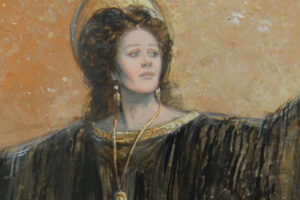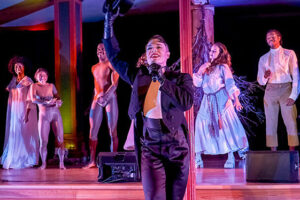
Jules Massenet’s Don Quichotte was one of a number of commissions from the Monte Carlo Opera that occupied the composer at the end of his life. He thought himself lucky to be tailoring the leading role for the great Russian basso Feodor Chaliapin, and he found himself falling in love with the young contralto hired to portray La belle Dulcinée at the premiere.
Alas, Massenet quickly became disappointed with Chaliapin’s overwrought portrayal and the young singer, Miss Lucy Arbell, turned out to be a demanding hoyden who, not only monopolized the leads in all his remaining operas but, made his last two years a misery. The opera however, having met with much success, enjoyed productions in Brussels, Paris, Marseille, New Orleans, Philadelphia and London before it was finally presented at the Metropolitan Opera in April of 1926.
There it received a review from Lawrence Gilman in the New York Herald Tribune so savage many historians regard it as the reason the opera fell from favor. Mr. Gilman, a great fan of Cervantes, couldn’t bear to see his beloved knight defiled by this French Philistine with ”the spiritual distinction of a butler, the compassionate understanding of a telephone girl, and the expressive capacity of an amorous tomtit.” (One of his parting shots is to ask the reader whether it’s time for the evening’s Dulcinée, Florence Easton, to “consider the benefits of a sagely chosen diet?”)
Mr. Gilman wasn’t the first critic to find this particular work of Massenet’s wanting. Gone is the voluptuousness of his more exotic operas, the veiled eroticisms of Herodiade and the emotional cyclone that is Werther, to be replaced with a much leaner palette of colors that befit this autumnal subject. Plenty of Spanish flavor, however, in the snappy choral writing and for the heroine. For this “Heroic Comedy in Five Acts” I initially had visions of Meyerbeerian excesses but it is compact in the extreme and plays for just two hours.
It’s such a frothy confection that I fear to breathe too hard on the score would blow the notes off the page. The libretto, based on a French play that was a fantasia of sorts on the Cervantes, is slim in the extreme. Don Quichotte, with his faithful Sancho Panza, is sent off by Dulcinée to return her pearl necklace that was stolen by bandits. Quichotte discovers the bandits and they, after nearly killing him, are so moved by his nobility that they give him the necklace. He tilts with a windmill that gets the better of him in between.
He returns the pearls to Dulcinée and publicly asks for her hand in marriage only to be mocked and derided by all present. She sends everyone off and quietly explains to him that they are too different for marriage. The crowd returns to poke more fun at the old man and Sancho responds with a passionate defense. Sadly, it’s all been too much and he leads his master off to die. The final scene when they say farewell to each other and Quichotte offers Sancho an “isle of dreams” as his reward for service is particularly moving.
This new DVD is a bittersweet document as it captures the retirement from the stage of José van Dam in May 2010. I’m certain I’m not alone in calling this man one of the greatest singing actors we’ve had the privilege of enjoying on the stage for the past fifty years. He’s left an indelible mark on many great roles as well as the song literature of the concert platform. I find it hard to name any singer with the level of innate dignity that his persona commands. To this end the Theatre La Monnaie made certain to give him a fitting tribute and farewell.
Laurent Pelly devised this production and designed the very clever costumes and was well supported by his favorite set designer Barbara de Limburg. The piece is staged as some sort of fantastic illusion dreamt by an old man reading his Cervantes. The stage becomes enveloped in stackes, then mountains and ravines, of paper to represent a character ‘lost’ in his own literature. The Toreador outfits on the men’s chorus are made from the same wallpaper pattern that adorns the old man’s room in Act I and the women are all in chaste white. It’s all ever so clever and charming—when Pelly isn’t trying too hard to impress.
Baritone Werner van Mechelen plays the oafish Panza with a sofa pillow down the front of this shirt and proves a most capable foil. Vocally he tends to brutish but he does rise abely to the occasion at the end of Act IV for his aria in defence of Quichotte.
Silvia Tro Santafé as the heroine starts at a disadvantage in her entrance aria as her voice is not yet centered. She makes her first entrance scooting down a large hill of papers on her derriére, which may account for her being momentarily off form. It’s a very small role in a very short opera but by her second appearance she’s displaying a lovely, tart vibrato and her aria and the duet that follows are the highlights of the night save the final scene. Pelly makes sure she’s magnificently frocked.
In a charming theatrical convention Dulcinée has a quartet of young suitors comprised of two sopranos, a tenor and a bass all garbed as men who comment on the action. They’re given some of the best melodies in the piece and blend well with each other.
Marc Minkowski whips this souffle to perfection in the pit and makes the most of a very tuneful score. He’s most excellent in the windmill scene of Act II and in the Entracte before the death scene where the first cellist has a moving solo.The chorus should get double time for all their rapid fire work in this piece.
Which leaves us with our Don Quichotte. At 70 years old Jose van Dam still displays many of the qualities that are the hallmark of his art, it just takes him a little longer to get there. The long breathed line may not be as firm but he still points and caresses his native language like no other. (For him, subtitles are unnecessary.)
He starts the first scene with the dry husk of what his voice once was. Luckily he improves as the evening continues and by Act II is finding his form. By the duet with Dulcinée and his death scene he’s in full command of his resources. His characterization certainly couldn’t be bettered. From his bemusement in the first scene all the way to his very touching farewell. I also can’t believe he was brave enough to participate in the windmill scene to the extent that he does. I have nothing but respect and admiration for him.
The Belgians, however, are very discreet in their attentions and although they applaud ferociously, with the Royal Family in attendance, only a few people stand at the calls. Very odd indeed.
Picture and sound are good, although the latter is only plain Dolby Digital, and my one serious caveat about the video direction is the strange choice of superimposing previous moments from the performance over the front curtain during the two exquisite entractes. Are we already nostalgic for what just happened? They could have certainly let the music stand on its own. Frankly, it’s just a distraction.
An excellent hour-long documentary works through the genesis of the production from creation of the set and costumes to casting and musical rehearsals with many interviews.
Gorgeous souvenir program book adorn the cardboard DVD case, which itself is decorated with the same wallpaper pattern mentioned above. The full list of chorus and orchestra with biographies of all the principals, an essay on the opera, an introduction by Laurent Pelly and a slew of photos all printed in color on creamy paper. I almost got teary remembering what is was like to buy an opera on record, with a booklet and actual words inside.
























Comments